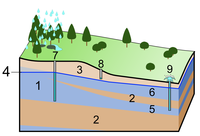
Photo from wikipedia
In regions experiencing aquifer depletion, planning for groundwater sustainability requires both accurate accounting of current groundwater budgets and an assessment of future conditions, with changes in recharge and pumping. Hydrologic… Click to show full abstract
In regions experiencing aquifer depletion, planning for groundwater sustainability requires both accurate accounting of current groundwater budgets and an assessment of future conditions, with changes in recharge and pumping. Hydrologic variability, climate change effects on water flows, changing water infrastructure operations, and inherent uncertainties in modeling, challenge the plans to achieve groundwater sustainability. This paper examines the importance, magnitude, and policy implications of uncertainties in groundwater overdraft estimation for water management in California. We review water balance estimates from two regional-scale groundwater models-C2VSim and CVHM-for sub-regions within California's Central Valley, and examine the variability and uncertainty in historical and future estimates of groundwater overdraft. Assuming reductions in agricultural water use for sub-regions with overdraft, we estimate the probabilities of ending groundwater overdraft for different periods. We also obtain the economic costs associated with these reductions in agricultural production. Results from both groundwater models show significant inter-annual variability in flows affecting groundwater storage, and our model comparison highlights the uncertainty in water budget estimates for Central Valley sub-regions given the differences between models. The analysis of the probabilities of achieving sustainability at the sub-regional scale show that the average overdraft rate is important and that greater variance in annual groundwater storage increases uncertainties in ending overdraft, especially for shorter periods. Greater reductions in annual net water increases the reliability of achieving groundwater sustainability, but rising rapidly agricultural economic losses. Setting management thresholds below groundwater levels can ease meeting sustainability criteria, but also can introduce a false pathway to sustainability. Finally, we discuss policy implications for the design of local groundwater sustainability plans and state assessment and regulation of local plans.
Journal Title: Journal of environmental management
Year Published: 2020
Link to full text (if available)
Share on Social Media: Sign Up to like & get
recommendations!